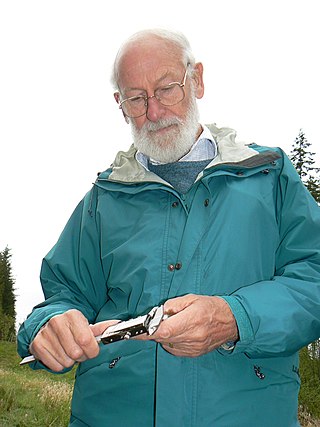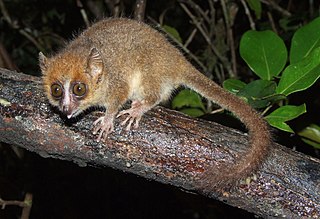
Evolutionary biology is the subfield of biology that studies the evolutionary processes that produced the diversity of life on Earth. It is also defined as the study of the history of life forms on Earth. Evolution holds that all species are related and gradually change over generations. In a population, the genetic variations affect the phenotypes of an organism. These changes in the phenotypes will be an advantage to some organisms, which will then be passed on to their offspring. Some examples of evolution in species over many generations are the peppered moth and flightless birds. In the 1930s, the discipline of evolutionary biology emerged through what Julian Huxley called the modern synthesis of understanding, from previously unrelated fields of biological research, such as genetics and ecology, systematics, and paleontology.

Peter Raymond Grant and Barbara Rosemary Grant are a British married couple who are evolutionary biologists at Princeton University. Each currently holds the position of emeritus professor. They are known for their work with Darwin's finches on Daphne Major, one of the Galápagos Islands. Since 1973, the Grants have spent six months of every year capturing, tagging, and taking blood samples from finches on the island. They have worked to show that natural selection can be seen within a single lifetime, or even within a couple of years. Charles Darwin originally thought that natural selection was a long, drawn out process but the Grants have shown that these changes in populations can happen very quickly.

Douglas Joel Futuyma is an American evolutionary biologist. He is a Distinguished Professor in the Department of Ecology and Evolution at Stony Brook University in Stony Brook, New York and a Research Associate on staff at the American Museum of Natural History in New York City. His research focuses on speciation and population biology. Futuyma is the author of a widely used undergraduate textbook on evolution and is also known for his work in public outreach, particularly in advocating against creationism.

The mouse lemurs are nocturnal lemurs of the genus Microcebus. Like all lemurs, mouse lemurs are native to Madagascar.

Naomi E. Pierce is an American entomologist and evolutionary biologist who studies plant-herbivore coevolution and is a world authority on butterflies. She is the Hessel Professor of Biology and Curator of Lepidoptera in the Department of Organismic and Evolutionary Biology at Harvard University.

Lemurs were first classified in 1758 by Carl Linnaeus, and the taxonomy remains controversial today, with approximately 70 to 100 species and subspecies recognized, depending on how the term "species" is defined. Having undergone their own independent evolution on Madagascar, lemurs have diversified to fill many ecological niches normally filled by other types of mammals. They include the smallest primates in the world, and once included some of the largest. Since the arrival of humans approximately 2,000 years ago, lemurs have become restricted to 10% of the island, or approximately 60,000 square kilometers (23,000 sq mi), and many face extinction. Concerns over lemur conservation have affected lemur taxonomy, since distinct species receive increased conservation attention compared to subspecies.
Sarah Perin Otto is a theoretical biologist, Canada Research Chair in Theoretical and Experimental Evolution, and is currently a Killam Professor at the University of British Columbia. From 2008-2016, she was the director of the Biodiversity Research Centre at the University of British Columbia. Otto was named a 2011 MacArthur Fellow. In 2015 the American Society of Naturalists gave her the Sewall Wright Award for fundamental contributions to the unification of biology. In 2021, she was awarded the Darwin–Wallace Medal for contributing major advances to the mathematical theory of evolution.

The following outline is provided as an overview of and topical guide to evolution:
L. Lacey Knowles is an ecologist and evolutionary biologist known for her work with speciation, sexual selection, phylogeography, and evolutionary radiation. As of 2012, she is a professor at the University of Michigan and the curator of insects at the university's museum of zoology. She has been an elected member of the councils for the Society for the Study of Evolution and the Society of Systematic Biology. Knowles received her Ph.D. in Ecology and Evolution from the State University of New York at Stony Brook and had a Postdoctoral Fellowship in the Department of Ecology and Evolutionary Biology at the University of Arizona. Knowles has also served as an associate editor of scientific journals such as Evolution, Molecular Ecology, Systematic Biology, and Heredity. She is the author of Estimating Species Trees: Practical and Theoretical Aspects.
Danielle "Hopi" Elisabeth Hoekstra is an evolutionary biologist working at Harvard University in Cambridge, Massachusetts and serving as the Dean of its Faculty of Arts and Sciences. Her lab uses natural populations of rodents to study the genetic basis of adaptation. She is the C.Y. Chan Professor of Arts and Sciences and the Xiaomeng Tong and Yu Chen Professor of Life Sciences in the Department of Organismic and Evolutionary Biology and the Department of Molecular and Cellular Biology at Harvard University. She is also the Curator of Mammals at the Museum of Comparative Zoology and a Harvard College Professor. In 2014, Hoekstra became a Howard Hughes Medical Institute Investigator. In 2016, she was elected to the National Academy of Sciences, and in 2017, she was elected to the American Academy of Arts and Sciences. Hoekstra became the Edgerley Family Dean of Harvard's Faculty of Arts and Sciences in August 2023.
Ganzhorn's mouse lemur is a species of lemur described in 2016. The discovery was made by researchers at the German Primate Center. It was discovered in Madagascar among closely related species such as Madame Berthe's mouse lemur, already described in 2013. Due to their close resemblance, it was initially impossible to identify them as distinct species. It was only after genetic analyses that the species was established. The genetic study was done in collaboration with scientists at the University of Kentucky, the Duke Lemur Center and the University of Antananarivo in Madagascar.
The Nosy Boraha mouse lemur is a species of mouse lemur described in 2016 from Madagascar. It was discovered by a team of researchers at the German Primate Center. It was initially discovered among closely related species such as Madame Berthe's mouse lemur, Bemanasy mouse lemur, and Ganzhorn's mouse lemur. Morphological similarity made it impossible to identify them as distinct species. A genetic study was done in collaboration with scientists at the University of Kentucky, the Duke Lemur Center and the University of Antananarivo in Madagascar. The mtDNA sequencing revealed that the species was unique.
The Bemanasy mouse lemur, Microcebus manitatra, is a species of mouse lemur described in 2016 from Madagascar. It was discovered by a team of researchers at the German Primate Center. It was initially discovered among closely related species such as Madame Berthe's mouse lemur, Boraha mouse lemur, and Ganzhorn's mouse lemur. Morphological similarity made it impossible to identify them as distinct species. A genetic study was done in collaboration with scientists at the University of Kentucky, the Duke Lemur Center and the University of Antananarivo in Madagascar. The mtDNA sequencing revealed that the species was unique.

Jonah Ratsimbazafy is a Malagasy primatologist. In 2020, he was appointed President of the International Primatological Society.
Christine M. Drea is a researcher and professor of biology and ecology with a specialty in animal social behavior and sexual differentiation at Duke University, both primarily on hyenas and primates. Drea's work is focused on female dominant species and the hormonal activity, reproductive development, and social interactions of these animals. She is currently the Earl D. McLean Professor of Evolutionary Anthropology within the Trinity College of Arts & Sciences and the director of graduate studies for the Duke University Ecology program.
Keith A. Crandall is an American computational biologist, bioinformaticist, and population geneticist at George Washington University, where he is the founding director of the Computational Biology Institute, and professor in the Department of Biostatistics and Bioinformatics.

Mary J. O'Connell is an evolutionary genomicist and Associate Professor at the University of Nottingham. She is the Principal Investigator of the Computational & Molecular Evolutionary Biology Group in the School of Life Sciences at the University of Nottingham.

Berthe Rakotosamimanana was a primatologist and palaeontologist from Madagascar.

Christine M. Simon is an American evolutionary biologist and entomologist known for her work in the molecular phylogenetics of mitochondria and the behavior and evolution of cicadas. She is a professor of ecology and evolutionary biology at the University of Connecticut, the former editor-in-chief of the journal Systematic Biology, and the former president of the Society of Systematic Biologists.
Microcebus jonahi, or Jonah's mouse lemur, is a tiny species of primate. It weighs 60 g (2.1 oz) and has a body length of around 13 cm (5.1 in) and its tail measures around 13 cm as well. It is the 25th recognized species of mouse lemur and the 108th recognized species of lemur.












